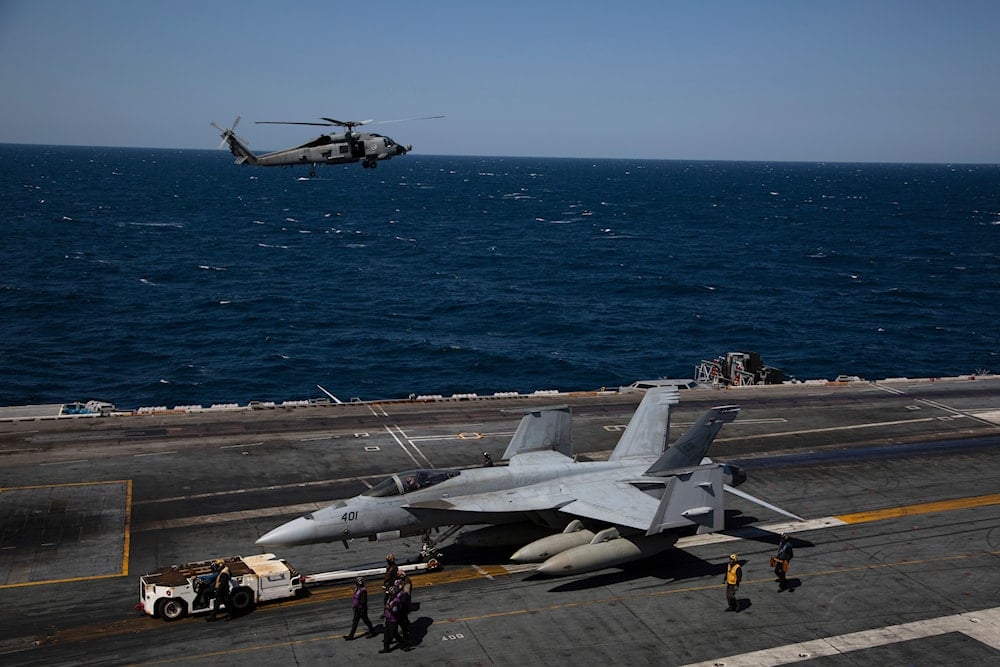USS Nimitz loses two aircraft in South China Sea in 30 minutes
Two US Navy aircraft, an F/A-18F Super Hornet and an MH-60R Sea Hawk, were lost from the USS Nimitz in the South China Sea.
-

United States Navy MH-60S Hawk helicopter, top, and F-18 Super Hornets are seen on the flight deck of the USS Nimitz off the coast of Busan, South Korea, on March 27, 2023. (AP)
Two US Navy aircraft operating from the aircraft carrier USS Nimitz were lost to the sea within roughly 30 minutes of each other: an MH-60R Sea Hawk and an F/A-18F Super Hornet.
On Sunday, search-and-rescue forces recovered all five personnel from the two incidents; troops were reported in stable condition. The US Pacific Fleet has characterized the events as separate incidents and opened formal investigations.
Timeline and immediate facts
The first incident involved an MH-60R Sea Hawk assigned to Helicopter Maritime Strike Squadron HSM-73; it went into the sea in the mid-afternoon while conducting routine carrier operations.
Approximately 30 minutes later, an F/A-18F Super Hornet from VFA-22 crashed into the South China Sea; both aviators ejected and were recovered. Official statements and reporting indicate both events occurred while the Nimitz was operating in the South China Sea during what has been described as routine deployment activity.
Peacetime losses in a contested theater
A single deck-oriented aviation mishap is an accepted operational risk; two losses from the same carrier within a short span are not. Carrier flight decks are among the most hazardous workplaces in peacetime precisely because routine activity concentrates high-energy operations in a confined, moving environment.
The coincidence of two different airframes, a rotary-wing anti-submarine warfare (ASW) platform and a strike fighter, being lost in quick succession raises immediate questions about whether the events are independent mishaps or symptoms of a common underlying problem, including maintenance, human factors, deck operations, or environmental conditions.
A series of US Navy 'mishaps'
During extended US operations in the Red Sea, including an all-out aerial and naval aggression against the Yemeni Armed Forces, the Navy recorded several high-profile aviation and deck incidents.
Aircraft were lost overboard, and friendly fire shot down a US fighter that the Navy later admitted to.
Those combat-adjacent mishaps, driven in large part by Yemeni missile and unmanned threats and by an unusually high operational tempo, differ in proximate cause from a routine-operations crash, but together they form a cluster that points to systemic pressure on American naval aviation readiness and risk margins.
How aircraft go overboard
On a carrier, parked and stowed aircraft are secured by brakes, chocks, and multiple tiedowns attached to deck padeyes; moving aircraft are handled with tractors, elevators, and carefully choreographed deck evolutions governed by standardized procedures.
An aircraft can go overboard when one or more protective layers fail: tiedown chains can part under extreme roll/heave or wind, fastening points can be improperly rigged or removed prematurely, tow vehicles or handling errors can permit an uncontrolled move, or a sudden ship maneuver, for example an emergency turn or severe roll in heavy sea state, can create loads that exceed restraints.
Active flight operations introduce other vectors. Bolters, arrested-landing failures, catapult or engine malfunctions, or deck strikes can send an aircraft into the water.
Read more: US fighter jet allegedly downed in 'friendly fire' over Red Sea
Material costs
The material loss is non-trivial. Modern Super Hornets and missionized Sea Hawks represent tens of millions of dollars apiece in direct replacement and far higher sums over lifecycle accounting; public reporting commonly places a unit-replacement estimate for a Super Hornet at around $70 million and the MH-60R at around $37 million, though precise figures vary by accounting method.
F/A-18 losses
- One F/A-18F Super Hornet was lost after an arresting cable failed during landing on the USS Harry S. Truman in May 2025.
- Another F/A-18E Super Hornet was lost in April 2025 when the crew lost control of the aircraft while it was being towed in the hangar bay, causing it and the tow tractor to fall overboard.
- A third F/A-18 Super Hornet was lost after it was accidentally shot down by the guided-missile cruiser USS Gettysburg.
USS Nimitz on its final deployment
The Nimitz is one of the US Navy’s older nuclear-powered carriers and was reported to be on its final deployment before decommissioning in May 2026. Aging platforms are not inherently unsafe, but prolonged deployments, deferred maintenance, and supply-chain friction raise the probability of mechanical or human-process failures.
Read more: Trump plans 'Golden Fleet' to modernize US Navy: WSJ
Geostrategic implications
Tactically, losing two aircraft is a direct hit to the USS Nimitz strike group’s operational strength in the region. But politically, the impact could be even greater.
The South China Sea remains one of the world’s most contested waters, where US naval presence serves as both a coercive measure against China and a reassurance to Washington’s allies. Incidents like these tend to draw sharp attention. They give rivals an opportunity to point to underlying problems related to US readiness and reliability while allies quietly watch how Washington manages the situation.
When seen alongside earlier mishaps in the Red Sea, including crashes, handling errors, and a friendly-fire shootdown, the Nimitz losses suggest a Navy stretched thin. High operational tempo, aging ships and aircraft, and pressure to sustain global deployments may be eroding safety margins.
Read more: Red Sea rising: Exposing the West's diminishing naval power

 5 Min Read
5 Min Read










